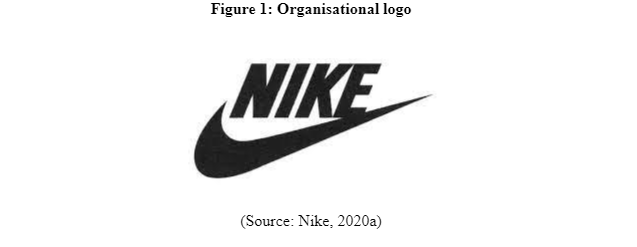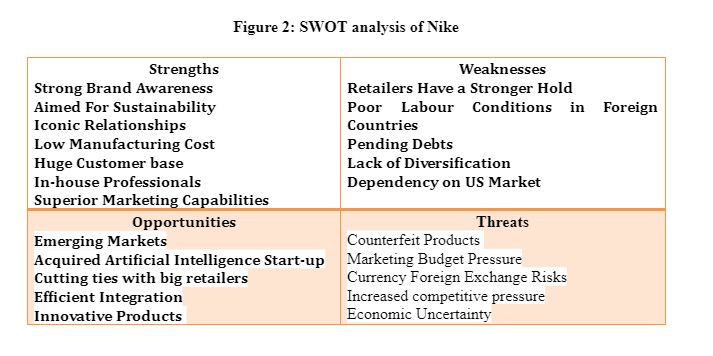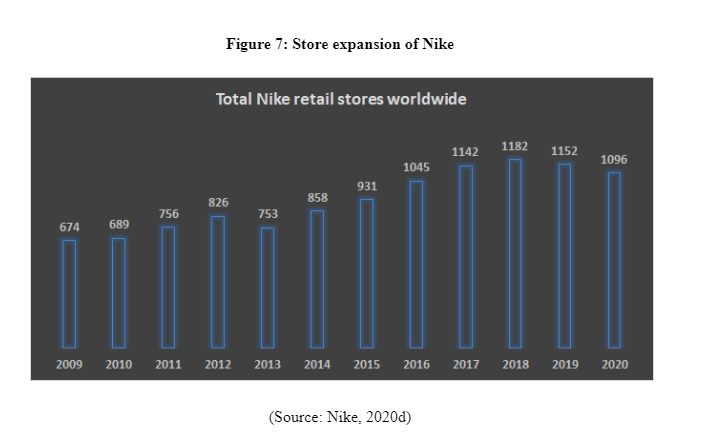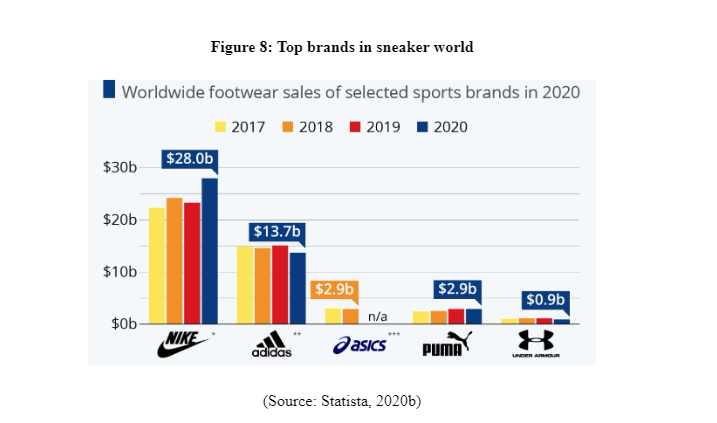Strategic Audit and Analysis of Nike
Introduction
In the recent era of globalisation, the organisational strategic planning is crucial to be developed well after strategic audit and market analysis, so that the firms can meet the strategic vision and gain high competitive advantage over other competitive firms in the market. The aim of the report is analyse conduct strategic audit on the renowned brand Nike, in order to acknowledge and strategic options of the company in order to secure future sustainable development. The study provides a scope to utilise the strategic models such as SWOT analysis, PESTLE analysis, Porter’s five forces and Ansoff’s Growth Strategies in order to understand the business environment of the firm and evaluate the strategic choices of Nike. For students seeking business dissertation help, this analysis offers valuable insights into strategic management practices.

2. Company background
Nike is an American multinational corporation that is efficient in designing, developing, manufacturing and marketing the sport related products and services worldwide. The major products of the brand are such as sport footwear, apparel, equipment, accessories and the other sport services. It is considered as the world’s largest supplier of athletic shoes and apparel for its proficient manufacturing units of sport equipment with the revenue in excess of US$37.4 billion in its fiscal year 2020. The company has employed more than 75,400 employees across the international markets, where the staff members are efficient to provide the best quality athletic products and services to wide numbers of customers (Nike, 2020a).

The mission of Nike is what drives us to do everything possible to expand human potential. The purpose of the brand is to create ground-breaking sport innovations by making the products roe sustainable, building creative and diverse global team and making positive impacts on the social communities across the globe. Nike vision is “to bring inspiration and innovation to every athlete in the world”. The slogan ‘Just Do It’ further influences the young generations and athletes to play well and achieve success through maximising their capabilities. The core values of Nike are such as innovation, sustainability, power of sports, team working activities, equality and diversity, community development and transparency. The organisation focuses on managing the core values to satisfy all the stakeholders, who are engaged with the business worldwide (Nike, 2020b).
3. Internal Strategic Audit

The major strengths of Nike are such as strong brand awareness, customer’s base is strong as well as there are in-house professionals who can make the shoes and other sport predicts by maintaining its quality and innovation. The superior marketing capabilities along with the sustainable solutions and iconic relation further create strong branding in the global industry (Nike, 2020c). The major weaknesses of the brand are high dependency on US market, increasing cost of marketing, Poor Labour Conditions in Foreign Countries and pending debt, for which the company would face difficulties in managing their global operations. The opportunities in the industry are such as emerging market growth, adopting artificial intelligence for client management and international operations handling, cutting ties with retailers for expanding own operations sustainably and increasing business innovation to satisfy the customers (Burgelman, 2017). The company also has some threats like increasing competitive rivalry, increasing cost of operations, foreign currency fluctuation and economic uncertainty for such recent pandemic situation.
4. External Strategic Audit
The external audit of the brand can be conducted through PESTLE and Porter’s five forces analysis, in order to acknowledge the external business environment, where Nike operates across the international markets. The PESTLE analysis for Nike will be evaluated further.


The threats of the competitive rivalry is strong due to existence of other competitive brands such as Adidas, Reebok, Puma, Converse, Fila, New Balance etc., which have strong market power in running their operational activities across the markets. Low market growth rate of Nike as well as high aggressiveness of the firm an moderate numbers of the firms are the major reason of having strong combative rivalry other firms have high market penetration and market saturation, and Nike is growing slowly across the international markets (O’Brien et al., 2019). The threat of new entrants is weak as their needs high cost for brand development, high economic of scale and moderate cost of ding business in the international sport apparel industry. Nike has it strong position to run their international operations, and it is quiet difficult for the new brands to enter and establish the organisation. The threat of substitute products is moderate as there are other substitute products in the sport apparel industry manufactured by other competitive firms. Moderate performance per price of substitutes and low switching cost of the customers further make the force moderate (Taylor, 2019). The bargaining power of the suppliers is also weak as the overall supply chain network of the company is strong and the suppliers are satisfied with the organisational activities. The bargaining power of the customers is moderate. Though the customer’s base is strong in Nike, but the switching cost of the buyers is low and there is availability of the substitute products in the market.
5. Porter’s Generic Strategies
As per the Porter’s Generic Strategies, the companies mainly focus on tactic of product differentiation, cost leadership, cost focus and differentiation focus. The company Nike mainly aims at providing the best quality products and services to the athletes and young generations in order to influence them to engage with sports and athletic games to achieve success (Hedstrom, 2018). Cost leadership strategy is being adopted by Nike, where production and operational cost is managed well through increasing economies of scale, where the company manufactures stylish products in large volume and distribute it among the retailers across the globe. On the other hand, the product diversification strategy is also adopted where there is strong product portfolio management at Nike (Nike, 2020d).
Figure 5: Porter’s Generic Strategies

The company focuses on the product diversification strategy by maintaining the quality of the products. The diverse product range including shoes, sports apparel, and accessories are effective to meet the customers’ requirements (Nica, Chiriță and Ionescu, 2021). They outsourced their manufacturing from 300 independent suppliers in 35 countries including Vietnam, Thailand, China and others. The products of the company are such as Nike Golf, Nike Pro, Nike+, Air Jordan, Nike Blazers, Air Force 1, Nike Dunk, Air Max, Foamposite, Nike Skateboarding, and Nike CR7. Hence, the customers can choose the shoes and other sport apparels as per their personal needs and preferences. The product range and affordable price are the major strategic position of the brand to gain high competitive advantage (Nike, 2020d).
6. Ansoff’s Growth Strategies
Ansoff’s Growth Strategies are effective for the organisations to choose the best planning for establishing the brand in such intensely competitive global market. Nike focuses on product development strategy as well as market development strategy. Through product diversification and marketing tactics, Nike focuses at improve branding and retaining the target customers in long run (Kaushikkar et al., 2020).

The company sell their products across 170 countries through store expansion and also by utilising the online platform. Hence, store expansion strategy is another business model of Nike to ensure brand presence and visibility of the products in the market. The market development strategy is fruitful for Nike to increase brand value and attract the audiences for their quality shoes and other sport accessories. The brand logo is strong to attract the athletes which represent the best quality of shoes and comfortable accessories for the customers (Nike, 2020d).

The quality of the shoes is maintained well where Nike has spent a lump sum amount on designing researching and developing the shoes and other sport apparels. Introducing the world to Air-Cushioning technology in shoes is another innovation of Nike where the company focuses on business innovation and creativity to serve the customer worldwide.

In the sneakers world, Nike is still in the first position as compared to other competitive firms like Adidas and Puma. Human resource management is another strategic planning of Nike, where the company hires strong research team including doctorates in biomedical engineering, biomechanics, kinesiology, mechanical engineering, physics, physiology, and systems science (Smith, 2020). The athletes, trainers, coaches, orthopaedists, podiatrists, equipment managers, and experts are also cooperative with each other to perform proficiently and operate across the globe by manufacturing the best quality shoes. It manages equality and diversity in order to manage the international employees and develop strong team or meeting the above mentioned strategic vision of the firm (Statista, 2020b).
Customisation is another feature that Nike provides where NikeID is a service, which allows the buyers to customise their shoes. The colour, style and tractions can be customised as per the personal needs and preferences of the customers. Nike utilises cud computing system as well as online purchasing e-commerce activities in order to stay connected with the buyers and develop trust and corporate bonding with them. Additionally, Nike spent 3.59 billion U.S. dollars only on advertising and promotional events in 2020 that indicates Nike spends 10% of its revenue on advertising their shoes and other athletic products. Nike utilises emotional advertising that every human being can identify with, offer premium products at premium prices and sell their products primarily through 3rd party retails stores. The promotional activities are innovative and influencing the young generations to boost their capabilities for better performance. Good branding through the slogan Just Do It as well as the social media campaign is effective for Nike to have successful positioning in the global sport apparel industry. Nike’s social media profile is ting with more than 138 million followers on Instagram and 8.3 million followers on Twitter. the company’s marketing tactics through social media advertisement includes collaboration with high profile people, appearing in customers conversation, distributing storytelling across the social media channels and creating user generated content that inspires the healthy and sporty lifestyle Nike has collaborated with many celebrities and influencers like Tiger Woods, Serena Williams, Rafael Nadal, etc. which inspires the people to make effective purchase decision for achieving success in sports. Customers’ conversation and feedback is handled well through the Twitter account, where Nike is able to share all the necessity updates about the products and services (Statista, 2020b). Smart product recommendation through effective brand website development is also another strategic planning for successful positioning of the brand, where Nike supports the customers and provide 24*7 services for resolving their queries and help them to choose the best products. The Nike app, Nike Training Club, Nike Run Club, and SNKRS are some loyalty programs that further hep the brand to enter into international markets and establish the brand sustainably by satisfying the clients (Nike, 2020d).
7. Summary of Analysis and Future Strategic Options
The sportswear industry in the world is dominated by Nike, Adidas and other sport apparel manufacturing companies and the market size is projected to reach US$ 113190 million by 2026, from US$ 93160 million in 2020. Nike has boosted the marketing strategy by shifting the public heath focus towards physical health and the importance of an active life. It further enhances the sale volume of the company.

Nike remains the best brand that is preferred by the teenagers and athletes. The mass marketing tactics of Nike is effective which caters to sports enthusiasts. As per market capitalisation, Nike becomes the first brand due to its strong customer’s base and the quality products and services available at the company. The brand value of Nike is more than 34.8 billion US dollar.

The company is hereby successful to secure future sustainable development by the major three strategies which are business innovation, product diversification and market development. The strategies are effective of the brand to maximise revue and make the firm profitable (Nike, 2020d).

The company is also successful to gain high market share through such strategic planning, Nike is the world's largest athletic shoe manufacture, with an estimated market share of about 50%. There is strong customer’s base and stable financial position, where the company can expand their business worldwide and gain higher competitive advantage than the competitive firms Adidas, puma and others. In order secure future sustainable development, Nike must focus on utilising enable resources or manufacturing the products, mainly shoes, which would be reusable in future after use. Additionally, zero emissions strategy must be incorporated in the firm by adopting latest technology. The introduction of artificial intelligence would be the best practice in Nike, to handle the employees and customers through robotics and automated system generation (Nike, 2020d).

8. Conclusion
Nike is hereby the strong sort apparel manufacturer in the international markets due to its innovative products and services. The company is financially stable and successful to generate revenue. Through the market development and product diversification strategy, the company is able to gain high market share worldwide. Through enhancing business creativity by artificial intelligence as well as manufacturing reusable shoes and raw materials and zero emission, the company would be world’s most sustainable brand in near future.
Continue your exploration of Strategic and Financial Performance Management with our related content.
Reference List
Burgelman, R.A., 2017. Complex strategic integration at Nike: Strategy process and strategy-as-practice combined. In Handbook of Middle Management Strategy Process Research. London: Edward Elgar Publishing.
Fung, Y.N., Choi, T.M. and Liu, R., 2020. Sustainable planning strategies in supply chain systems: proposal and applications with a real case study in fashion. Production Planning & Control, 31(11-12), pp.883-902.
Hedstrom, G.S., 2018. Strategic Planning. In Sustainability (pp. 169-180). De Gruyter.
Kaushikkar, A., Kirkewoog, S., Merckling, E., Prabhu, S., Daim, T.U. and Meissner, D., 2020. Sports Innovation. In Innovation Management in the Intelligent World (pp. 119-137). Springer, Cham.
Nica, I., Chiriță, N. and Ionescu, Ș., 2021. Using of KPIs and Dashboard in the analysis of Nike company's performance management. Theoretical & Applied Economics, 28(1).
Nike, 2020a. About us. [Online] Available at: https://about.nike.com/ [Accessed on 26 November 2021].
Nike, 2020b. Purpose. [Online] Available at: https://purpose.nike.com/ [Accessed on 26 November 2021].
Nike, 2020c. Sustainability. https://www.nike.com/sustainability [Accessed on 26 November 2021].
Nike, 2020d. Annual report 2020. [Online] Available at: http://d18rn0p25nwr6d.cloudfront.net/CIK-0000320187/72b61935-3ee0-4f79-a564-0d5134713574.pdf [Accessed on 26 November 2021].
O’Brien, D., Parent, M.M., Ferkins, L. and Gowthorp, L., 2019. Strategic management in sport. London: Routledge.
PANDEY, B.C., 2017. Nike Inc-Complete Analysis: SWOT, PESTLE and Marketing strategy. London: BookRix.
Smith, R.D., 2020. Strategic planning for public relations. London: Routledge.
Statista, 2020a. Brand value of the sports company Nike worldwide from 2016 to 2021. [Online] Available at: https://www.statista.com/statistics/632210/nike-brand-value/ [Accessed on 26 November 2021].
Statista, 2020b. Nike's revenue worldwide from 2005 to 2021. [Online] Available at: https://www.statista.com/statistics/241683/nikes-sales-worldwide-since-2004/ [Accessed on 26 November 2021].
Taylor, M., 2019. Evidence Based Marketing: Using Principles from the Profit Impact of Market Strategies (PIMS) Project by Benchmarking UK Firms and Global Sportswear Manufacturers (GSMs) Marketing Expenditure (Nike, adidas, VF Corp, Under Armour, Puma, Anta and BasicNet SpA). www. thecasecentre. org, (CASE-).
What Makes Us Unique
- 24/7 Customer Support
- 100% Customer Satisfaction
- No Privacy Violation
- Quick Services
- Subject Experts



